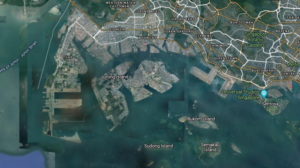Singapore Emerges as a Maritime Ammonia Center
By Stephen H. Crolius on March 10, 2021
Three recent announcements show Singapore emerging as a center for development of ammonia as a maritime fuel. In both cases, multi-party coalitions, with Singaporean connections, are focusing on ground-breaking work.
The Castor Project
Last month two parties signed onto the Joint Development Project, an undertaking that was launched in January 2020 with the goal of designing an ammonia-fueled tanker. The new members are Yara and the Maritime and Port Authority of Singapore (MPA). The JDP used the occasion to change its name to the Castor Project. (The group explains that Castor is “the second-brightest star in the Gemini constellation, but actually consists of six stars which appear as one.”) The JDP’s original members are Lloyd’s Register, MAN Energy Solutions, Samsung Heavy Industries, and MISC Berhad. MISC Berhad identifies itself as the “leading international shipping line of Malaysia.”
The addition of the MPA is especially significant in that it gives the ammonia bunker fuel concept a grounding at one of the world’s leading ports. Reuters cites the MPA as “the world’s largest bunkering hub.” A biennial survey conducted by marine classification society DNV-GL and Norwegian consultancy Menon Economics has given Singapore the top position on its list of “leading maritime capitals” since 2012. (According to an April 2017 Straits Times story, the study that year “looked at 24 objective indicators and garnered survey responses from more than 250 industry experts across all continents.”)
The announcement describes the original JDP partners’ activities over the last year. MAN Energy Solutions has been focused on the engineering parameters that will need to be adapted to use ammonia as an internal combustion engine fuel. Samsung Heavy Industries has been working on the design of the tanker and is making preparations to build the vessel when the time comes. Lloyd’s Register has conducted “early safety appraisals and research into the development of suitable fuel storage and supply systems.”
Ammonia as a Marine Fuel in Singapore
Maritime ammonia safety is also the focus of the second Singaporean initiative. A January 25, 2021 press release from the marine classification society American Bureau of Shipping (ABS) reports that a group has formed to study “the potential of ammonia for Singapore, exploring supply, bunkering, and safety challenges with the marine fuel,” and more generally “safety protocols and possible gaps in the supply chain of ammonia as a marine fuel, specifically bunkering for marine vessels.” The group plans to produce a report under the title Ammonia as a Marine Fuel in Singapore – Supply Chain, Bunker Safety, and Potential Issues. The initiative will be among the first anywhere to specifically address the safety issues associated with ammonia bunkering operations from a port-specific perspective.
The effort will be led by ABS, Nanyang Technological University Singapore (NTU), and the Ammonia Safety and Training Institute (ASTI). It is not a surprise to see these organizations in the lead on an initiative of this nature. ABS refers in the press release to its “industry-leading experience with ammonia,” citing its Ammonia as Marine Fuel white paper which evaluates “the challenges in design and operation of ammonia-fueled vessels.” As it happens, ABS, NTU, and ASTI were all represented at the 2020 edition of the Ammonia Energy Association Australia’s Ammonia = Hydrogen 2.0 Conference. It was reported that ABS and ASTI expressed a “desire to cooperate in developing safety training courses for mariners on ships powered by ammonia.”
Other partners in the study include MAN ES, the only organization that is participating in both initiatives. (MAN ES may have discovered a common interest with NTU when both were represented in a panel discussion entitled “Green Ammonia as Maritime Bunker Fuel” during the AEA Australia conference.) Another partner, Japanese trading company Itochu, launched a Singapore-based initiative in 2020 with Royal Vopak, a Dutch company that bills itself as “the world’s leading independent tank storage company.” The two plan to “study the feasibility of developing an infrastructure” at Vopak’s Banyan Terminal, leading to the “establishment of supply chain of ammonia marine fuel in Singapore.” The MPA oversees not a singular “port of Singapore” but a series of terminals arrayed along the Singapore Strait. Vopak’s Banyan Terminal is located in close proximity to the Jurong Port. Jurong Port Pte Ltd., one of two port terminal operators retained by MPA to manage the port facilities, is another partner in the study. PSA Singapore, the other port terminal operator, is yet another.
The last two partners in the project are ExxonMobil and Höegh LNG. The latter describes itself as “a fully Integrated LNG infrastructure company offering LNG transportation services, LNG regasification, terminal solutions and in-house ship management services.” It maintains an operating presence in Singapore. Jurong Island is the site of ExxonMobil’s “largest integrated refining and petrochemical complex in the world.” Neither company has a preexisting profile in the ammonia energy field.
Joint Feasibility Study
The latest announcement came just this week from yet another maritime-ammonia-oriented coalition based in Singapore. According to a company press release, marine carrier A.P. Moller – Maersk A/S will work with five other parties on “a feasibility study [aimed at] establishing a comprehensive and competitive supply chain for the provision of green ammonia ship-to-ship bunkering at the Port of Singapore.” The partners include Hong Kong-based ship management services provider Fleet Management Limited; Singapore’s own Keppel Offshore & Marine, which engages in a range of shipbuilding and repair activities; Copenhagen-based R&D consortium Maersk Mc-Kinney Moller Center for Zero Carbon Shipping; Sumitomo Corporation; and Yara.
